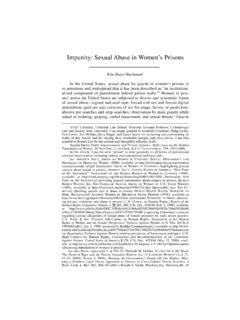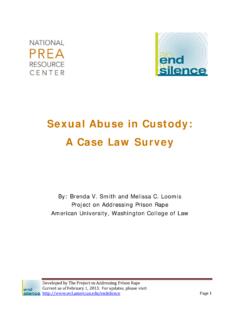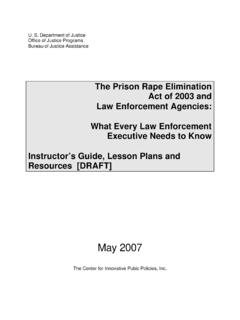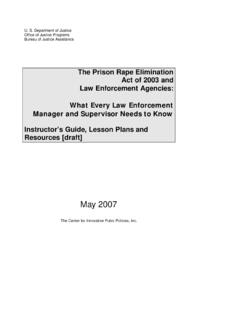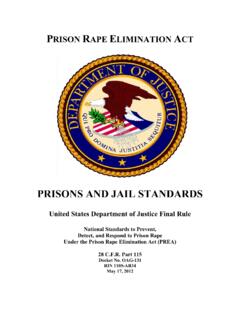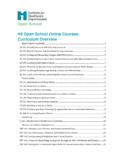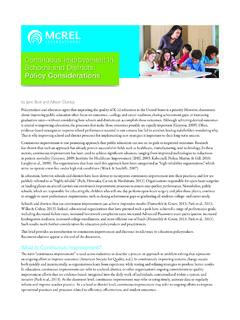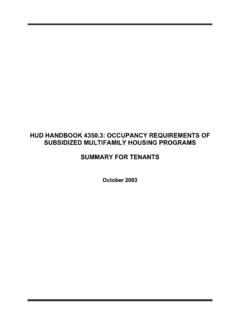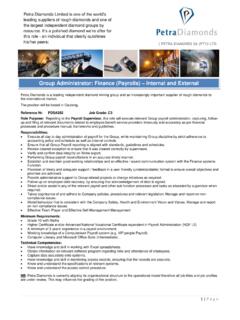Transcription of What is SOGIE? - PREA Resource Center
1 Why do we need to know a youth s SOGIE? Similar to other parts of our identity, like race and ethnicity, SOGIE matters. SOGIE is an important piece of our identity that can determine and shape our needs and experiences. Why are we collecting SOGIE information? Alameda County s Department of Children & Family Services is committed to providing high-quality and equitable care to all youth. Understanding the whole child is necessary to ensure positive outcomes. Research tells us that certain youth experience differential treatment as a result of their SOGIE. Current best practices in the child welfare field state that collecting SOGIE is an important first step to better understanding the lives, experiences, and possible unique challenges of LGBTQ and gender non-conforming youth in the child welfare system.
2 The intersection of race with one s SOGIE is multifaceted and must be considered. What will we do with the information? NCCD will review and analyze the information gathered to determine if there is disproportionality within our practice or disparate outcomes for children and youth based on SOGIE and the intersection with race. The findings from that analysis will be shared with the department executive team and the department s LGBTQ Workgroup to guide their efforts for the upcoming year. How will we collect the information? Primary Child Welfare Workers will collect the information using a one-page questionnaire during their visits with children and youth, ages 10-21, in the months of November and December 2014.
3 What is SOGIE? SOGIE is an acronym that stands for Sexual Orientation, Gender Identity, and Gender Expression. EVERYBODY has one! INTERVIEWING TIPS for gathering SOGIE information from children and youth: 1. Be mindful of your own beliefs, values, cultural norms, and gaps in knowledge surrounding sexual orientation, gender identity, and gender expression. 2. Your goal is to create a safe space for youth to disclose their SOGIE; be aware of your non-verbal reactions, especially if a youth discloses something different than what you anticipated. 3. A hesitancy to disclose SOGIE in the beginning is common given the harassment and discrimination many LGBTQ and gender non-conforming children and youth have encountered. Therefore, a child or youth may opt out the first time you meet.
4 If so, please inquire again during the following visit. 4. If a youth tells you that they are gay, lesbian, bisexual, transgender, queer, or questioning: Be affirming ( , thank them for sharing); Discuss it (ask questions like: Who have you told? Do you feel supported?); Do not include in dependency files or the court documents WITHOUT youth s consent; Explore what it means to them and how it connects to their identity and behaviors; and Discuss concerns, challenges, and any next steps for best practice with your supervisor. Youth Name: Youth DOB: / / Who: ALL children and youth ages 10 21 years When: During monthly visits in November and December 2014 Why: These are questions about how children and youth see themselves.
5 We know everyone is unique, but we have not always been good at talking about or identifying that. Our organization is working very hard to figure out what is important to children and youth and how best to support them. Questions (check all that apply) 1. Were you born a boy, girl, or something else? Boy Girl Something else: 2. Do you feel like a boy, girl, or something else? Boy Girl Something else: 3. Do you prefer to wear boy clothes or girl clothes? Boy clothes Girl clothes Depends on the day 4. Do you like and/or date girls, boys, both, or neither? Girls Boys Both Neither 5. Are you gay, lesbian, bisexual, queer, questioning, straight, or something else? Gay Lesbian Bisexual Queer Questioning Straight Something else: NOT TO BE INCLUDED in dependency file or court document WITHOUT youth s consent.
6 Return completed questionnaires to your supervisor. Confidential SOGIE Questionnaire Child welfare supervisors are asked to present this information to their staff at a unit meeting in the month of October. THANK YOU! We will be conducting a SOGIE PDSA in the months of November and December. WHAT is a PDSA? PDSA is a problem-solving model used for improving a process or carrying out change. The model for improvement, PDSA (Plan, Do, Study, Act), was designed to test and implement changes with the idea that small practice changes have a significant impact on child welfare. Our department used this model to identify Native American children and families with whom we work; we also conducted a PDSA around the use of hot words in the ERU/Screening process.
7 WHY collect SOGIE now? As you know, during the past several months, department staff received training on SOGIE from Amy Cipolla-Stickles of NCCD in preparation for this next step. This SOGIE information collection is the second phase of our work and commitment to: Provide quality and equitable care to all children and youth we serve; Accurately and confidentially assess the proportion of foster youth who identify as LGBTQ and gender non-conforming; and Assess whether LGBTQ or gender non-conforming youth are overrepresented in our department, as the latest research shows for other jurisdictions/states. Expected outcomes of the work: A better understanding of the experiences of the children and youth within our department.
8 A better understanding of how best to allocate resources to support children and youth. Increased awareness regarding the intersection of race and SOGIE as we continue our work on disproportionality. WHO will collect SOGIE information? Primary child welfare workers with open caseloads FROM WHOM are we collecting SOGIE information? Children and youth between the ages of 10-21 WHEN will we collect SOGIE information? During monthly visits in November and December 2014 HOW will the SOGIE information be collected from the workers? 1. After workers gather the SOGIE information from the children and youth on their caseloads, they will return the completed questionnaires to their supervisors. 2. Supervisors will put the completed questionnaires in the envelope provided by NCCD.
9 3. At the end of November and December, Amy Cipolla-Stickles or a member of the LGBTQ Workgroup will collect the completed questionnaires. SOGIE PDSA Instructions for Child Welfare Supervisors

